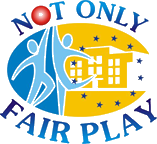
- Home
- Best
Practices - Toolkits
How to ... - Sport
Events - Guidelines
- Information
& Contacts - Project Management
A collection of student stories and initiatives about sport.
This section offers access to a collection of toolkits to promote sport at school.
-
 Physical Education Teachers
They are the main point of reference for students at school
Physical Education Teachers
They are the main point of reference for students at school
-
 Teachers
Teachers of all subjects can contribute to promote sport at school
Teachers
Teachers of all subjects can contribute to promote sport at school
-
 School Directors
Their support is a key element to promote sport at school
School Directors
Their support is a key element to promote sport at school
-
 Resources
A database of resources for teachers, PE teachers and school directors for the promotion of sport at school.
Resources
A database of resources for teachers, PE teachers and school directors for the promotion of sport at school.
Sporting events are organised in each partner country
Guidelines for policy makers willing to raise awareness on the importance of promoting sport in schools
Events
The Not Only Fair Play project has been promoted through conferences and articles.
Partnership
-
 Contractual Partners
From this section it is possible to access a description of each contractual partner of the Not Only Fair Play project.
Contractual Partners
From this section it is possible to access a description of each contractual partner of the Not Only Fair Play project.
-
 Schools
From this section it is possible to access information about the schools involved in the Not Only Fair Play Project in the 9 European countries involved.
Schools
From this section it is possible to access information about the schools involved in the Not Only Fair Play Project in the 9 European countries involved.
-
 Associated Partners
A number of associated partners officially joined the project in order to ensure the project sustainability by continuing to use the project deliverables over the next years.
Associated Partners
A number of associated partners officially joined the project in order to ensure the project sustainability by continuing to use the project deliverables over the next years.
This section of the Not Only Fair Play portal provides administrative information for the project contractual partners and for the European Commission, and is password protected.
School Directors
Homepage > Toolkits > School Directors

Their support is a key element to promote sport at school
Back to the School Directors Toolkits
How to promote the importance of sport at school
A Toolkit for School Director
Strategies :
• Create a physical activity experience that is fun and focuses on young people feeling good, gaining confidence and enjoying what they do.
• Create programmes which encourage young people to increase their physical activity levels throughout the whole day, not just at school.
• Promote a ‘mastery climate’, ie, an environment where young people are encouraged to develop their individual skill levels and personal best.
• Provide opportunities to try a wide variety of activities including some which are more likely to be attractive to those who are less sporty, such as creative activities like dance or cheerleading.
• Ensure activities are developmentally appropriate and use positive reinforcement to recognise effort and progress
- Practical strategies for promoting physical activityIdentifying and using strategies that are both effective and cost-effective is important to ensure efficient use of available resources and funding. This briefing brings together the available research evidence as well as practical strategies to outline recommended approaches and actions for effectively promoting physical activity in children up to 12 years.
- Assessment in Physical EducationThis is the chapter 6 of the Physical Education Curriculum Framework and it is states that assessment in PE serves many purposes and contributes to decision making. In order to support this thesis many factors, as for example the different forms of assessment, the teaching – learning – and evaluation process, are taken into account.
- Practical strategies for promoting physical activityIdentifying and using strategies that are both effective and cost-effective is important to ensure efficient use of available resources and funding. This briefing brings together the available research evidence as well as practical strategies to outline recommended approaches and actions for effectively promoting physical activity in children up to 18 years.
- Ten Strategies for Schools to Promote Physical Activity and Healthy EatingThe guidelines provide information on how schools can encourage pupils be more physically active


